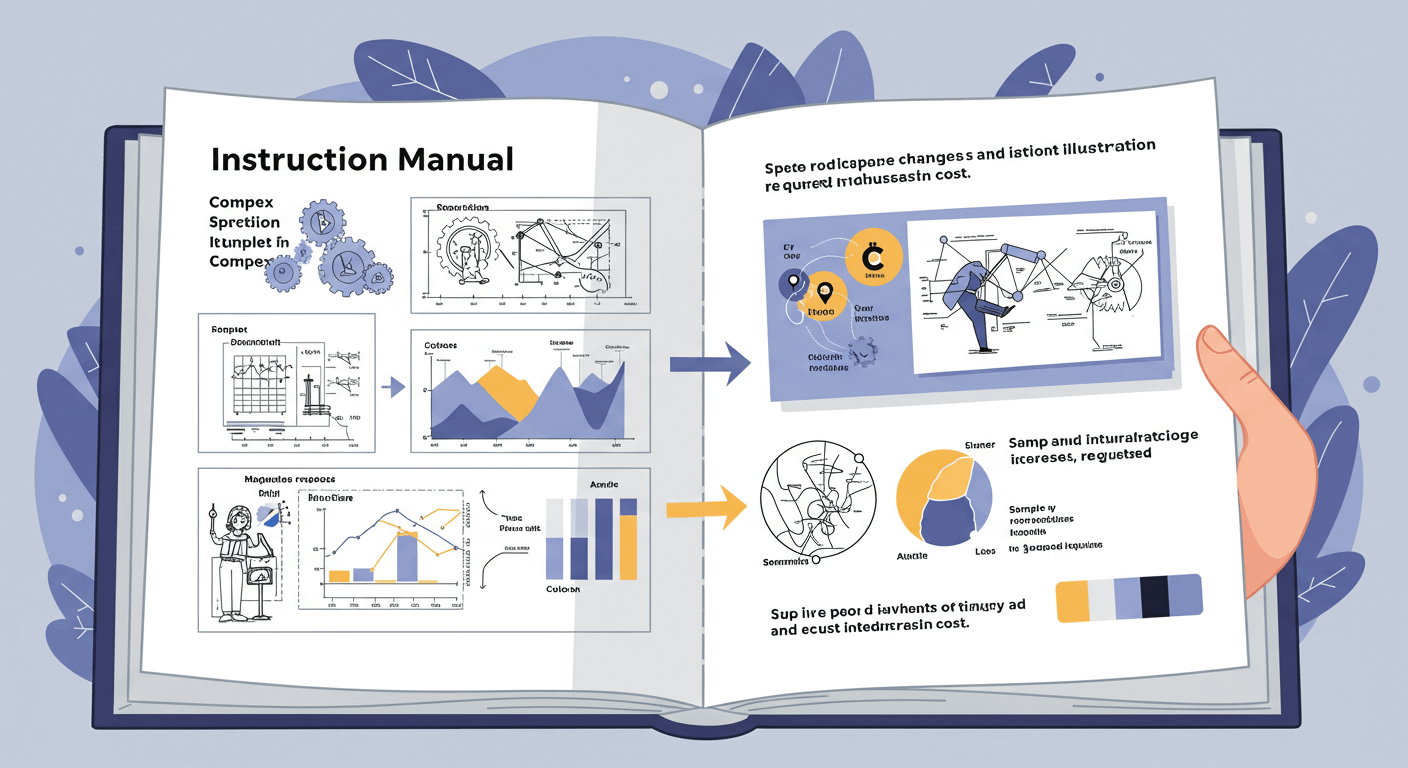Instruction Manual Illustration Rates Per Page: What Influences Cost?

Instruction manuals are essential tools that help users understand how to operate, assemble, or maintain a product safely and effectively. At the heart of every well-designed manual is a series of illustrations that simplify complex steps, reduce ambiguity, and enhance user experience. However, these visuals come at a cost—and understanding what influences instruction manual illustration rates per page can help you budget effectively and ensure you’re getting real value.
This article explores the typical pricing range for manual illustrations, the key cost factors, and how to make informed decisions that reflect both quality and return on investment.
Table of Contents
ToggleWhat Are the Average Illustration Rates Per Page?
The cost of instruction manual illustrations depends on several elements, including complexity, industry standards, and whether you’re hiring a freelancer or working with a creative agency. On average, here’s what you can expect:
| Type of Illustration | Estimated Rate (Per Page) |
|---|---|
| Basic line art (simple icons, steps) | $50–$100 |
| Moderately detailed 2D illustrations | $100–$300 |
| Advanced technical/3D renderings | $300–$500+ |
These rates are only averages. Depending on your product type and audience expectations, rates can rise—especially in regulated industries such as medical devices, automotive, or industrial equipment.
Factors That Influence Illustration Costs
1. Complexity and Level of Detail
The most significant factor affecting cost is the complexity of the illustrations. A simple line drawing of a screwdriver being inserted into a screw will be far less expensive than a multi-layered exploded view of a machine engine.
- Simple illustrations: Minimal lines, flat icons, little detail.
- Moderate illustrations: Labeled diagrams, shaded parts, multiple angles.
- Complex illustrations: 3D visuals, moving parts, detailed environments.
The more time an illustrator spends modeling, labeling, or shading an image, the higher the price.
2. Industry-Specific Requirements
Certain industries require compliance with design and documentation standards. For example:
- Medical device manuals often demand regulatory accuracy and may require legal review of each image.
- Aerospace and manufacturing may require illustrations that meet ISO or ANSI standards.
- Consumer electronics often include multilingual manuals, which may require illustration adaptations.
Illustrators with experience in these sectors may charge higher rates due to their specialized knowledge.
3. Style and Branding Needs
Some brands demand a specific illustration style that aligns with their visual identity—such as isometric line art, minimalist black-and-white graphics, or photorealistic renderings.
Custom styles often require:
- Template development
- Color palette matching
- Typography consistency
All of this adds to the time required per page and thus affects the rate.
4. Number of Illustrations and Total Page Count
Illustrators and agencies often offer discounts for larger projects. A single-page manual with four simple images might be quoted at the high end, while a 50-page manual with recurring templates or repeated components may benefit from volume pricing.
- Small projects (1–5 pages): No discount, premium pricing per page
- Medium projects (10–25 pages): 10–20% discount likely
- Large projects (25+ pages): 20–30% discount possible
Bundling also allows for visual consistency, which improves the clarity and professional appearance of your manual.
5. Revision Rounds and Collaboration
Many illustrators include 1–2 rounds of revisions in their quote. However, if your internal team needs frequent changes—or if your product is still evolving—you may incur additional costs.
Clear communication between your engineers, product managers, and illustrators will streamline revisions and reduce back-and-forth.
6. Turnaround Time
Urgency significantly influences cost. Standard turnaround times (7–21 days) come at a regular rate. But if you need illustrations in under a week, expect to pay a 25–100% rush fee.
Longer timelines also allow illustrators to deliver better quality, review their work, and incorporate user feedback when available.
7. Licensing and Usage Rights
Some illustrators charge based on how the images will be used:
- Limited-use license: For a specific manual or product only
- Commercial-use license: Allows you to use the illustration across marketing, packaging, and digital platforms
- Exclusive rights or copyright transfer: Full ownership, which commands the highest rates
Be clear about your usage intentions from the start to avoid hidden costs later.
Improving Manual Quality Beyond Cost
While pricing is important, illustrations are not just visual aids—they shape the user’s perception of your product and brand. High-quality illustrations make a manual easier to understand, more professional in appearance, and more valuable to the end user.
Here’s how to ensure your manual illustrations are both impactful and trustworthy:
Reflect Real Product Use
Illustrations should depict real-world scenarios and reflect actual user experiences. This means:
- Showing proper hand placement or tool usage
- Depicting common user mistakes and how to avoid them
- Demonstrating assembly steps that users frequently misunderstand
This shows that the manual was designed with actual product experience in mind, increasing its reliability and usefulness.
Use Expert Review and Cross-Disciplinary Input
Involving your product engineers, technicians, or safety officers in the manual development process ensures your illustrations are technically accurate and compliant.
Some best practices include:
- Having engineers review diagrams before final approval
- Including a statement in the manual like: “All content verified by the product design team”
- Cross-referencing each illustration with product specifications
This reinforces trust and ensures the user is following safe, accurate steps.
Maintain Consistent Visual Standards
A manual that uses inconsistent illustration styles, varying icon sizes, or unclear labeling can confuse the user. Invest in style guides and templates that:
- Define line thickness and spacing
- Set a consistent label font and size
- Standardize how tools and components are shown
Visual consistency gives the impression of professionalism and quality—something customers notice and appreciate.
Offer Transparency and Ongoing Support
The manual should provide more than instructions. It should reflect your company’s commitment to supporting the user. You can build this into your illustrations and design by:
- Including a “Last Updated” date or version number
- Offering contact information or support links in every section
- Adding QR codes that link to how-to videos or FAQs
This positions your manual not as a static PDF, but as part of a broader, helpful user ecosystem.
Conclusion
The cost of instruction manual illustrations varies—typically ranging from $50 to $500 per page—based on complexity, style, industry requirements, and volume. But price is only one part of the equation.
To create illustrations that truly serve your users and your brand, focus on accuracy, clarity, visual consistency, and practical relevance. When users feel guided, not confused, by your manual, it reflects positively on your product—and your company as a whole.
A thoughtful investment in illustration pays off through fewer support calls, faster user adoption, and stronger brand trust.
FAQs
1. What is the typical cost of an instruction manual illustration per page?
The cost can range from $50 to $500+ per page, depending on factors such as complexity, industry standards, and illustration style. Basic line drawings are more affordable, while highly detailed technical or 3D renderings cost more.
2. What factors affect the cost of manual illustrations?
Key factors include:
- Complexity and level of detail
- Industry-specific requirements
- Style and branding consistency
- Total number of pages or illustrations
- Revision rounds
- Turnaround time
- Licensing and usage rights
3. Are bulk or multi-page discounts available?
Yes, many illustrators and agencies offer discounts for larger projects. The more pages or recurring visuals you need, the lower the cost per page may be.
4. Can I use the illustrations elsewhere, like in marketing materials?
Only if you have the correct license. Be sure to clarify usage rights with the illustrator. Some agreements cover manual use only, while others include broader commercial usage.
5. How do I ensure the illustrations are accurate and helpful?
Work closely with your internal product, engineering, and QA teams. Review all illustrations for technical accuracy and clarity. It also helps to test the manual with real users to catch potential confusion.







